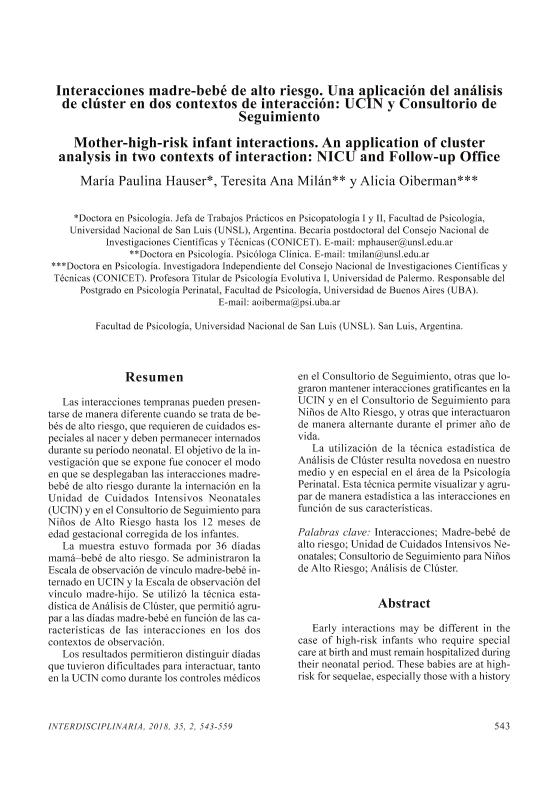Artículo
Las interacciones tempranas pueden presentarse de manera diferente cuando se trata de bebés de alto riesgo, que requieren de cuidados especiales al nacer y deben permanecer internados durante su periodo neonatal. El objetivo de la investigación que se expone fue conocer el modo en que se desplegaban las interacciones madre-bebé de alto riesgo durante la internación en la Unidad de Cuidados Intensivos Neonatales (UCIN) y en el Consultorio de Seguimiento para Niños de Alto Riesgo hasta los 12 meses de edad gestacional corregida de los infantes. La muestra está formada por 36 díadas mamá?bebé de alto riesgo. Se utilizó La Escala de observación de vínculo madre-bebé internado en UCIN y La Escala de observación del vínculo madre-hijo. Se utilizó la técnica estadística de Análisis de Clúster, que permitió agrupar a las díadas madre-bebé en función de las características de las interacciones en los dos contextos de observación. Los resultados permitieron distinguir díadas que tuvieron dificultades para interactuar tanto en la UCIN como durante los controles médicos en el Consultorio de Seguimiento; otras díadas lograron mantener interacciones gratificantes en la UCIN y en el Consultorio de Seguimiento para Niños de Alto Riesgo; y finalmente, otras díadas interactuaron de manera alternante durante el primer año de vida. La utilización de la técnica estadística de Análisis de Clúster resulta novedosa en nuestro medio y en especial en el área de la Psicología Perinatal. Esta técnica permite visualizar y agrupar de manera estadística a las interacciones en función de sus características. Early interactions may be different in the case of high-risk infants who require special care at birth and must remain hospitalized during their neonatal period. These babies are at highrisk for sequelae, especially those with a history of prematurity, low birth weight, neonatal conditions and important psychosocial problems. At the birth of a child with some difficulty, parents experience a multiplicity of feelings that result in the vicissitudes of interactions and the mother-father-child bond. In these cases, there is a greater relational risk, which is why there are greater possibilities for the appearance of dysfunctional bonding modalities. The objective of the research that is exposed was to know the way in which mother-high-risk infant interactions were deployed during hospitalization at the Neonatal Intensive Care Unit (NICU) and in the Follow-up Office for High-Risk Children up to 12 months corrected gestational age of infants. The sample is made up of 36 mother-highrisk baby dyads. We used the Mother-Child Bond Observation Scale in the NICU during the period of hospitalization of the baby in the NICU. Observations were made when the mother entered the NICU to see her child while in the incubator. The first observation of the dyad should be made during the first month of life of the baby, performing the following with intervals of two or three days in order to know if there were variations with the course of hospitalization time, maturation and growth of the baby. At follow-up, spontaneous mother-child interactions that occurred in the natural observational context of the High-Risk Child FollowUp Office were evaluated using the MotherChild Bond Observation Scale. It was observed monthly to each dyad during the 15-25 minutes of the pediatric visit. The statistical technique of Cluster Analysis was used, which allowed to group the mother-infant dyads according to the characteristics of the interactions in the two observational contexts. The results allowed us to distinguish dyads who had difficulty interacting both in the NICU and during the medical exam at the Follow-up Office; other dyads were able to maintain rewarding interactions in the NICU and in the Follow-up Office for High-risk Children. Finally, other dyads interacted alternately during the first year of life, either because they established satisfactory interactions during the infant's hospitalization in the NICU, although later these interactions became significantly impoverished during the first year of life. Or had difficulties in interacting in neonatal therapy, which decreased considerably after discharge, with frequent and rewarding interactions observed during the infant's follow-up in the first year of life. The importance of the application of Cluster Analysis in the field of research in Psychology lies in the possibility of visualizing and grouping in a statistical way, in our case, the interactions according to their characteristics, in two different moments such as Hospitalization in NICU and in the Office of Follow-up for High-Risk Children. The use of the statistical technique of Cluster Analysis is novel in our environment and especially in the area of Perinatal Psychology. Key words: Interactions; Mother-High-risk baby; Neonatal Intensive Care Unit; Follow-up Office for High-Risk Children; Cluster Analysis
Interacciones madre-bebé de alto riesgo. Una aplicación del Análisis de Clúster en dos contextos de interacción: UCIN y Consultorio de Seguimiento
Título:
Mother-high-risk infant interactions. An application of cluster analysis in two contexts of interaction: NICU and Follow-up Office
Fecha de publicación:
12/2018
Editorial:
Centro Interamericano de Investigaciones Psicológicas y Ciencias Afines
Revista:
Interdisciplinaria
ISSN:
0325-8203
Idioma:
Español
Tipo de recurso:
Artículo publicado
Clasificación temática:
Resumen
Archivos asociados
Licencia
Identificadores
Colecciones
Articulos(CIIPME)
Articulos de CENTRO INTER. DE INV. EN PSICOLOGIA MATEMATICA Y EXP. "DR. HORACIO J.A RIMOLDI"
Articulos de CENTRO INTER. DE INV. EN PSICOLOGIA MATEMATICA Y EXP. "DR. HORACIO J.A RIMOLDI"
Citación
Hauser, Maria Paulina; Milan, Teresita Ana; Oiberman, Alicia Juana; Interacciones madre-bebé de alto riesgo. Una aplicación del Análisis de Clúster en dos contextos de interacción: UCIN y Consultorio de Seguimiento; Centro Interamericano de Investigaciones Psicológicas y Ciencias Afines; Interdisciplinaria; 35; 2; 12-2018; 543-559
Compartir




